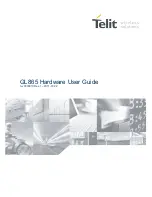
149
CHAPTER 9. INSTRUCTION SET
9.1
SPECIAL INSTRUCTIONS
This section outlines the special instructions of the
µ
PD75402A instruction set.
9.1.1
Bit Manipulation Instructions
µ
PD75402A bit manipulation can be performed by various instructions, such as the following:
(a)
Bit set
:
SET1
mem. bit
SET1
fmem. bit
(b)
Bit clear :
CLR1
mem. bit
CLR1
fmem. bit
(c)
Bit test :
SKT
mem. bit
SKT
fmem. bit
(d)
Bit test :
SKF
mem. bit
SKF
fmem. bit
(e)
Bit test & clear :
SKTCLR
fmem. bit
(f)
Boolean operation:
AND1
CY, fmem. bit
OR1
CY, fmem. bit
XOR1
CY, fmem. bit
fmem. bit is the bit address specified by special address bit manipulation addressing.
Especially, since I/O ports can always use all the bit manipulation instructions above, I/O port operation can be
performed very efficiently.
9.1.2
Stack Instructions
The following two kinds of stack instructions are available with the
µ
PD75402A.
(a)
MOV A, #n4 or MOV XA, #n8
(b)
MOV HL, #n8
“Stack” signifies that these two kinds of instructions are placed in contiguous addresses.
Example
A0 :
MOV A,
#0
A1 :
MOV A,
#1
XA7: MOV XA, #07
When stack instructions are stacked such as in the example above, when the address executed first is A0, it is
executed by replacing the next two instructions with NOP instructions. When the address executed first is A1, it is
executed by replacing the next instruction with an NOP instruction. That is, only the instruction executed first is
effective, all the stack instructions following it are processed as NOP instructions.
Constants can be efficiently set to accumulator (A register, register pair XA) and data pointer (register pair HL)
by using these stack instructions.
















































